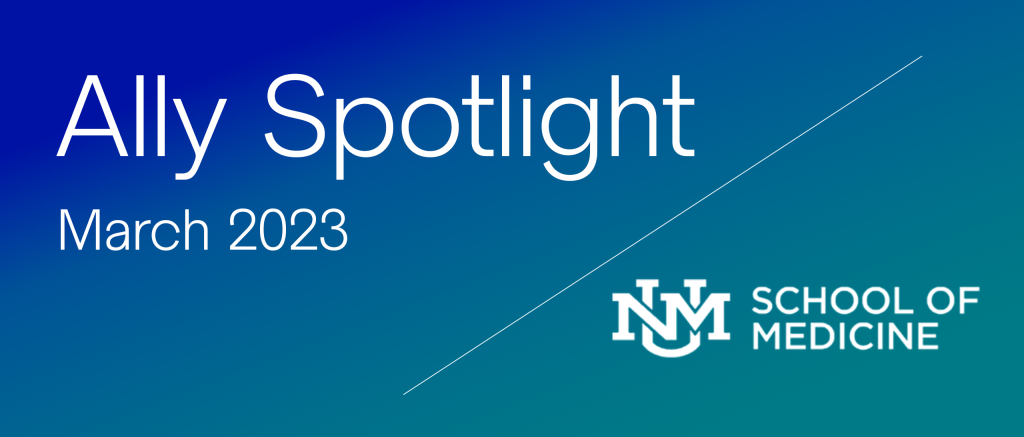March Ally Spotlight with the University of New Mexico School of Medicine Learning Environment Office

Each month, the Social Mission Alliance highlights the important work done by our allies.
This month, we spoke to the University of New Mexico School of Medicine about their Learning Environment Office (LEO). Their stated mission is “to foster an inclusive learning environment where teachers, staff, and learners thrive, and relationships are mutually respectful and beneficial to each other and to our institutional climate. The primary goals of the Learning Environment Office are to increase exemplary behavior exhibited by teachers and staff and decrease incidents of learner mistreatment.”
Read below for our interview with the LEO’s Director, Diana Martínez, as she answers our questions about why the LEO was formed, how it fosters an inclusive learning environment, and recommendations for other programs that wish to combat learner mistreatment.
Q&A
Q: Why was the Learning Environment Office at the University of New Mexico formed?
Mistreatment in medical education is a nationally recognized concern. In 2019, former leaders at the University of New Mexico (UNM) School of Medicine (SOM), Drs. Paul Roth and Martha McGrew, were extremely concerned with increasing rates of mistreatment at UNM reported by graduating medical students to the Association of American Medical Colleges through the Graduation Questionnaire. Despite prior interventions, UNM’s rates of mistreatment were rising and were consistently above national averages. In July 2019, the Learning Environment Office was born. Now in 2023, LEO is a team of 11: three full-time staff members and two part-time administrative staff members, as well as six affiliated faculty members. LEO serves all UNM SOM learners including medical students, residents, fellows, biomedical research students, and students in our 7 health professions programs, which include Emergency Medicine Services, Dental Hygiene, Medical Laboratory Sciences, Occupational Therapy, Physical Therapy, Physician Assistant, Occupational Therapy, and Radiologic Sciences programs.
We are aware that learner mistreatment does not happen in a vacuum. It is a microcosm of society and its interlocking systems of power and oppression. Unfortunately, in these three short years of LEO, we have endured a global pandemic, continued reckoning with racial injustices, climate change, mass shootings, religious persecution, an insurrection, targeted attacks on trans children and people, and the erosion of fundamental rights. Mistreatment within medical and research education is connected to what is happening around us locally, nationally, and globally. Learning environments can be shaped either positively or negatively by how we as an institution and we as individuals respond or remain silent. Moving forward together toward supportive, respectful, and inclusive learning and working environments is directly related to the success of our institution, our health system, patientcare, and each of us.
Q: How does the Learning Environment Office help create and maintain positive learning environments, both for students and educators?
Upon LEO’s founding, we were intentional about framing LEO’s work as inseparable from the work of inclusion and culture transformation. To that end, LEO helps create and maintain supportive, respectful, and inclusive learning environments by engaging in three distinct but overlapping areas of work: Attention, Prevention, and Intervention. LEO’s Attention work highlights positive learning environments and great teachers, such as through recognition programs. This positive feedback encourages teachers to continue to invest time and energy in teaching, especially during times of increasing burnout. LEO’s Prevention work helps leaders, programs, and teachers build their skills to prevent and reduce incidents of mistreatment and promote positive learning environments. This may include trainings on conflict transformation, early interventions into environments that might have problems brewing, responding to microaggressions, or skill-building for individuals on giving feedback in stressful situations. LEO’s Intervention work involves responding to individual reports of learner mistreatment. This response may be individual recommendations to help a teacher improve, an audit of a complex environment to learn what factors are at play, or an improvement plan co-created with a department chair or program director.
Our ultimate goal is to foster an inclusive learning environment where teachers, staff, and learners thrive, and relationships are mutually respectful and beneficial to each other and to institutional climate.
Q: In what ways has the Learning Environment Office changed the student experience at UNM?
Unfortunately, learner mistreatment is a culture and systems issue. It’s not as simple as re-training a few faculty members; the culture of medical and health professions education has largely been based on enforced hierarchies, exclusion, and public humiliation. The current generation of healthcare providers graduated from a system that humiliated, dehumanized, and traumatized them. Undoing that work and changing this culture is a years-long process. But we’re trying! In other words, we are not expecting mistreatment data to turnaround immediately. Addressing, reducing, and preventing individual incidents is necessary but not sufficient. We must assess policies and practices. We must analyze trends and design interventions accordingly. We must take into account the ways societal and medical culture and systems of oppression shape our own institution and inform individual behavior.
LEO has laid the foundation for systems transformation by creating and staffing an anonymous (if desired) and confidential reporting system, engaging in trust-building, and increasing transparency and accountability. In many ways, LEO is still in its infancy and becoming known as a trusted space for learners and teachers alike has been a huge success thus far, and is critical for the long-term work of culture and systems change.
Q: What recommendations do you have for other healthcare education programs to combat learner mistreatment?
Some of the things LEO has implemented that we recommend are:
- Staff Led Office with Dedicated FTE: Many schools of medicine run mistreatment reports through a faculty member with part-time FTE. This is not enough coverage, and faculty may be perceived by learners as “on the side of” other faculty. Giving full-time FTE to staff members helps build trust and capacity for responding to a high volume of incidents (LEO receives ~20 per month). Moreover, staff are never in the position to evaluate learners, so by design of LEO, we have removed one of the potential anxieties for reporting.
- Centralizing and Expanding Reporting so that each environment is not tracking its own mistreatment incidents. Centralizing the reporting hub with anonymous options ensures consistency, standardization, and a more impartial response.
- Consistent Processes: Pre-LEO, each department or environment responded to mistreatment as they saw fit, which meant there was no consistency across the school. Imagine a medical student rotating through several departments—if they are mistreated on two subsequent rotations, they should be able to report those incidents to one centralized place, and the response to those two incidents should be the same. Implementing consistent and transparent practices helps to build trust with learners and teachers, because everyone knows what to expect.
- Communicating Transparently to learners, teachers, and the SOM as a whole about trends, data, and what happens when reports are filed. This process should not be a mystery, and teachers should know what happens after a report about them is made, just as learners should know what their options are.
- Training Beyond Compliance: Strong policies are essential, but adhering to legal minimums is insufficient to create positive, inclusive, and respectful learning environments. For example, rather than focusing on meeting minimum ADA requirements, encourage leaders to design programs and curriculum that center learners with disabilities and are inherently adaptive.
- Data Evaluation for Tracking Trends: Often learners are too fearful of retaliation to let LEO take action. But even documenting their concerns and using them as de-identified data points helps LEO take the temperature of each environment and make appropriate recommendations or interventions.
- Working Collaboratively with Others: LEO works with every acronym at the SOM, including Office of Graduate Medical Education (GME), Offices of Undergraduate Medical Education, Office of Diversity, Equity, and Inclusion, Office of Professional Wellbeing, Disability Services, Title IX, and others. For example, LEO and GME will collaborate on special reviews or learning environment audits in programs with high numbers of mistreatment reports and low scores on ACGME evaluations.
The Social Mission Alliance would like to thank Diana Martínez and The University of New Mexico School of Medicine Learning Environment Office for taking the time to talk with us, and for their continued commitment to social mission.
To learn more, Diana Martínez also spoke about the Learning Environment Office in a recent webinar titled “The War of Attrition in Health Professional Education,” hosted by our Student Assembly.

